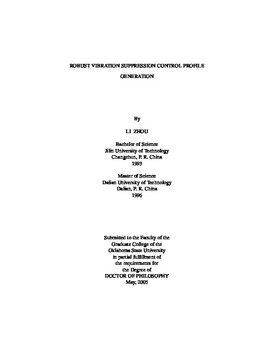| dc.contributor.advisor | Misawa, Eduardo A. | |
| dc.contributor.author | Zhou, Li | |
| dc.date.accessioned | 2013-12-10T18:05:24Z | |
| dc.date.available | 2013-12-10T18:05:24Z | |
| dc.date.issued | 2005-05 | |
| dc.identifier.uri | https://hdl.handle.net/11244/7828 | |
| dc.description.abstract | Scope and Method of Study: | |
| dc.description.abstract | The control of flexible structures has been extensively studied in recent years. Flexible structures such as high-speed disk drive actuators require extremely precise positioning under very tight time constraints. Whenever a fast motion is commanded, residual vibration in the flexible structure is induced, which increases the settling time. One solution is to design a closed-loop control to damp out vibrations caused by the command inputs and disturbances to the plant. However, the resulting closed-loop response may still be too slow to provide an acceptable settling time. Also, the closed-loop control is not able to compensate for high frequency residual vibration which occurs beyond the closed-loop bandwidth. An alternative approach is to develop an appropriate reference trajectory that is able to minimize the excitation energy imparted to the system at its natural frequencies. | |
| dc.description.abstract | Findings and Conclusions: | |
| dc.description.abstract | A robust vibration suppression control profile is generated which suppresses all the high frequency vibrations in a flexible dynamic system. This robust control profile is the shifted time-limited version of the functions that optimally achieve the energy concentration property. The robust control profile is designed by considering the first resonance frequency. In practical system, a lower resonance frequency mode may exist which is located far from the high frequency resonance modes. In this case, a robust control profile is generated which suppresses one specific resonant mode in a flexible dynamic system. This robust control profile is a smooth function which can be used as a robust velocity profile, or as a robust shape filter to an arbitrary control command. The robustness can be arbitrarily improved, which brings about a smoother profile. Combination of high frequency vibration suppression control profile and low frequency vibration suppression control profile generates a robust vibration suppression control profile that is able to suppress all the resonant dynamics in a flexible dynamic system. The technique can be applied to both open-loop and closed-loop systems. | |
| dc.format | application/pdf | |
| dc.language | en_US | |
| dc.rights | Copyright is held by the author who has granted the Oklahoma State University Library the non-exclusive right to share this material in its institutional repository. Contact Digital Library Services at lib-dls@okstate.edu or 405-744-9161 for the permission policy on the use, reproduction or distribution of this material. | |
| dc.title | Robust vibration suppression control profile generation | |
| dc.contributor.committeeMember | Pagilla, Prabhakar R. | |
| dc.contributor.committeeMember | Young, Gary E. | |
| dc.contributor.committeeMember | Hagan, Martin T. | |
| osu.filename | Zhou_okstate_0664D_1413.pdf | |
| osu.accesstype | Open Access | |
| dc.type.genre | Dissertation | |
| dc.type.material | Text | |
| thesis.degree.discipline | Mechanical Engineering | |
| thesis.degree.grantor | Oklahoma State University | |
